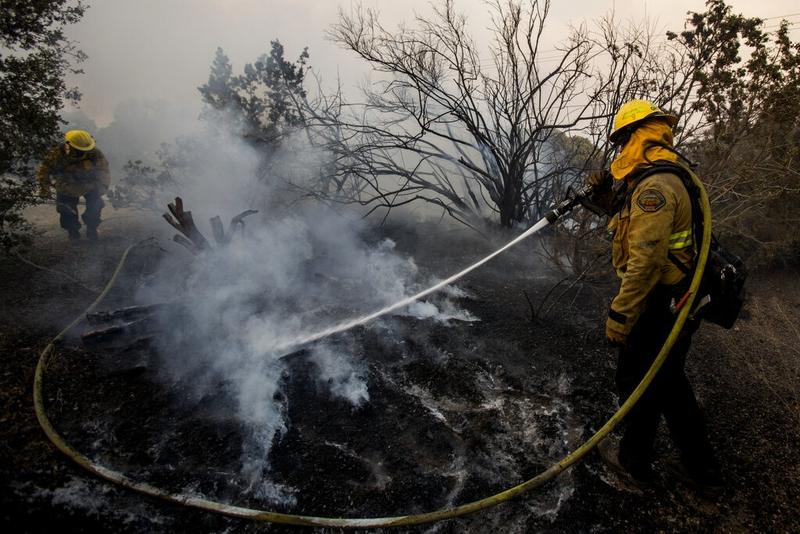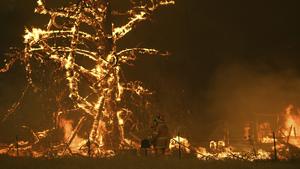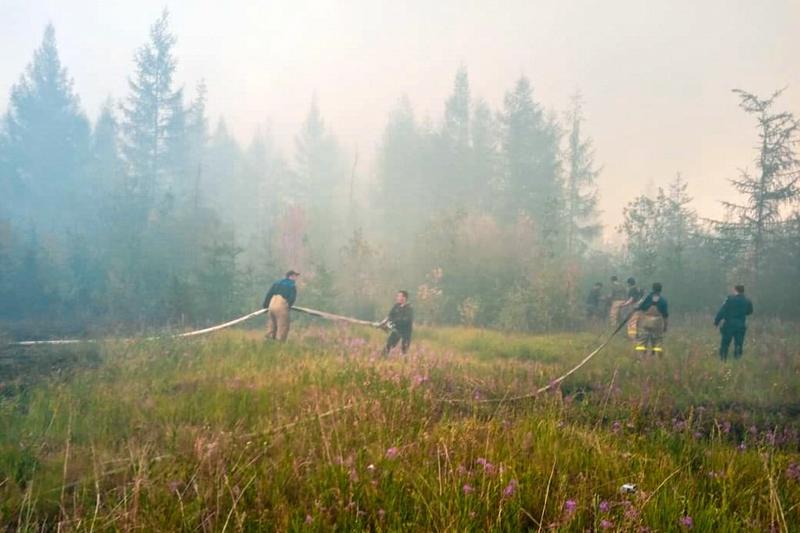 A firefighter works to douse hotspots from the Bobcat Fire in Juniper Hills, California, Sept 18, 2020. (RINGO H.W. CHIU / AP)
A firefighter works to douse hotspots from the Bobcat Fire in Juniper Hills, California, Sept 18, 2020. (RINGO H.W. CHIU / AP)
LONDON - Wildfires among ponderosa pines and Douglas firs of the US West have long been part of nature's cycle of renewal, as much as the changing of the seasons.
But as climate change makes the region more arid, wildfires have grown more frequent and ferocious. Scientists worry the hottest blazes could end up obliterating swathes of some forests forever.
What we're seeing with fires in California and elsewhere around the world is that fire is really responsive to climate change.
Jennifer Balch, Fire ecologist at the University of Colorado Boulder, US
"When you get these large areas burned there are no surviving trees to reseed these areas," said Jon Keeley, a research scientist with the US Geological Survey. "It is causing a shift from forest to other vegetation types, mostly shrublands and grasslands."
ALSO READ: Top companies urge action on nature loss ahead of UN talks
Climate change has made these landscape-changing wildfires a concern worldwide. This year, record fires have also raged in Australia, Argentina and the Siberian Arctic. The fires in these regions have also been exacerbated by heat and drought conditions made worse by climate change, scientists say.
"What we're seeing with fires in California and elsewhere around the world is that fire is really responsive to climate change," said Jennifer Balch, a fire ecologist at the University of Colorado Boulder.
That is bad news for temperate and boreal forests, which unlike tropical forests such as the Amazon have evolved over millennia to need occasional fire outbreaks for their own renewal, scientists say. Whether these woodlands can survive more intense wildfire scenarios will depend on two key issues – how frequently the fires come, and how hot they burn.
 Joshua trees are consumed by the Bobcat Fire in Juniper Hills, California, Sept 18, 2020. (RINGO H.W. CHIU / AP)
Joshua trees are consumed by the Bobcat Fire in Juniper Hills, California, Sept 18, 2020. (RINGO H.W. CHIU / AP)
'Tree-torching' in the US West
This year's deadly fires in the United States had devoured a record of nearly 5 million acres as of Sunday, a scale of devastation that fits into the longer-term trend of more acreage being scorched as temperatures rise.
Historically, fires in the region tended to burn low to the ground, eliminating dead conifer limbs, keeping competing species in check and prompting pine cones to open and disperse their seeds.
These days, fire crews are seeing increasing cases of massive "tree-torching" fires that engulf forests from the ground up through the canopy.
This year's deadly fires in the United States had devoured a record of nearly 5 million acres as of Sunday, a scale of devastation that fits into the longer-term trend of more acreage being scorched as temperatures rise
"Fires are not unnatural, but the kind of behaviour and the times, places and conditions they are igniting in are very, very unusual," said Timothy Ingalsbee, who heads the Firefighters United for Safety, Ethics, and Ecology, an Oregon-based advocacy group that promotes forest management to mitigate fire risks.
If fires sweep a forest too frequently, they will wipe out saplings before they can reach maturity. Too hot, and the fire can turn large areas into a moonscape barren of the seeds needed for new growth. Climate change could fuel conditions for both scenarios.
In California, a rise of 1.4 degrees Celsius in average summertime temperatures since the 1970s coincided with a five-fold increase in acreage burned annually, researchers reported last year in the American Geophysical Union.
READ MORE: Trump visits California, Biden talks climate change as wildfires rage
The same dry conditions that aggravate the fires also undermine new forest growth.
"In some hotter and drier areas, the climate has shifted to the point where it's no longer suitable for tree regeneration," said Kimberley Davis, an ecologist at the University of Montana.
"In those areas, once there is a fire, trees won't grow back."
In the Rocky Mountain region over the next 30 years, climate change and wildfires could shrink ponderosa pine areas by 16 percent and Douglas fir acreage by 10 percent, according to research by Davis and colleagues in Environmental Research Letters.
 In this Dec 21, 2019, photo, crew members of the New South Wales Rural Fire Service fight the Gospers Mountain Fire as it impacts a property at Bilpin, New South Wales state, Australia. (DAN HIMBRECHTS / AAP IMAGES VIA AP)
In this Dec 21, 2019, photo, crew members of the New South Wales Rural Fire Service fight the Gospers Mountain Fire as it impacts a property at Bilpin, New South Wales state, Australia. (DAN HIMBRECHTS / AAP IMAGES VIA AP)
In Australia, 'the system crashed'
Scientists in Australia are already seeing evidence that fire is reshaping landscapes, possibly irreversibly.
A series of unusually frequent blazes in the southeastern Australian Alps since 2003 has caused forest systems there to collapse, said David Bowman, a fire scientist at the University of Tasmania.
"As we're doing the research project, another fire happened: Then the system crashed," Bowman said. "It went from a forested state to a non-forested state. No forest, no trees – Kaput."
READ MORE: The Australian dream is dying in the wildfires
 This image grab taken from an undated handout video released by the Russian Emergency Ministry shows firefighters fighting to extinguish forest fires near the village of Batagay, Sakha Republic in Yakutia. (RUSSIAN EMERGENCY MINISTRY / AFP)
This image grab taken from an undated handout video released by the Russian Emergency Ministry shows firefighters fighting to extinguish forest fires near the village of Batagay, Sakha Republic in Yakutia. (RUSSIAN EMERGENCY MINISTRY / AFP)
'Feedback cycle' in the Arctic
Even more worrying, scientists say, is an apparent increase in wildfires in the Siberian Arctic, which can thaw permafrost and release climate-warming methane from the frozen land.
Satellite observations over the last two decades revealed frequent burnings in Siberia’s boreal forest, which might have required a fire only once every 80 to 200 years to regenerate.
READ MORE: Worst-ever Arctic fires released record amount of CO2
That increase could be evidence of a fire regime change, said Thomas Smith, a geographer at the London School of Economics.
"It's very difficult for ecosystems to adapt to that pace of change," Smith said. "It's going to be catastrophic in terms of the loss of carbon when you move from forest to non-forest, and that's part of this positive feedback cycle."


